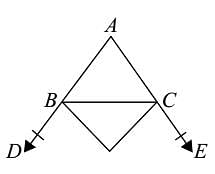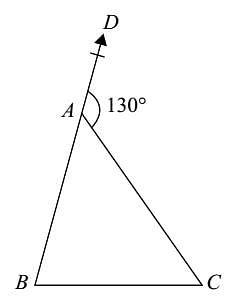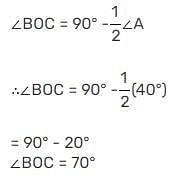DSE Odisha TGT Science CBZ Mock Test - 3 - OTET MCQ
30 Questions MCQ Test DSE Odisha TGT Mock Test Series 2024 - DSE Odisha TGT Science CBZ Mock Test - 3
Nala dynasty (4-5 century AD) was centered around which modern districts of Odisha?
Who became the first Indian male to win the prestigious Fields Medal in Mathematics?
| 1 Crore+ students have signed up on EduRev. Have you? Download the App |
Krishna Raja Sagara reservoir, recently seen in the news, is located in which state?
The sides AB and AC of ΔABC have been produced to D and E respectively. The bisectors of ∠CBD and ∠BCE meet at O. If ∠A = 40°, then ∠BOC is equal to:

In the following figure, ∠B : ∠C = 2 : 3, find ∠B + ∠C.

The following three aspects of intelligence are dealt with by Sternberg's triarchic theory except:
What is the primary goal of the National Education Policy (NEP) 2020?
In your class, you find that some students cannot understand a topic because of the wide gap in their previous knowledge. What would you do?
One of your students has written an application to you urging that he wants to utilise the games period by studying science in the school library. You disapprove of this because you know that it is essential for students to play games as
Under NEP 2020, what is the focus of the new National Curriculum Framework (NCF)?
An electron in a hydrogen atom in its ground state absrobs energy equal to the ionisation energy of Li+2. The wavelength of the emitted electron is
Correct arrangement of Al, Cu, Fe, Mg and Zn in the order in which they displace each other from the solution of their salts is
Using the following Latimer diagram for bromine, pH = 0;

the species undergoing disproportionation is:
Which of the following exhibit cis-trans isomerism?
Development is the sum of how many processes?
You forget to add Cytokinin the culture medium, there will be very little growth as Cytokinin is essential for
What is the primary role of chlorophyll in photosynthesis?
Which growth is also called apparent growth?
Mediterranean orchid Ophrysensures pollination by :
Ecological pyramids does not give any place to :
The maximum possible number of individuals that a habitat can support is called its
The biodiversity of a given region is an outcome of
















